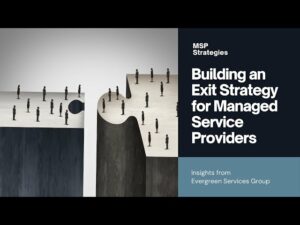For all my videos about managed services providers and IT services companies, I should have one that explains exactly what these companies are if you have absolutely no experience with the space. This is that video.
To understand what IT services, specifically managed services, it is valuable to have some background on how we got here. Let’s go back in time to the beginning of personal computing, the introduction of the PC.
In the 1970s, computers that would qualify in this space were done by hobbyists or were build-it-yourself. IBM is generally credited with creating a formalized product offering here, and there’s lots of great information out there if you want to learn how it came to be. What’s important is that in 1981, it launched, and from day one, it was distributed via channels. To distribute these new computers, IBM turned to ComputerLand; Sears, Roebuck and Co.; and IBM Product Centers to make the IBM PC available to the broadest set of customers.
From IBM’s website, “The response to the announcement was overwhelming. One dealer had 22 customers come in and put down $1,000 deposits on the machines for which he could not promise a delivery date. By the end of 1982, qualified retail outfits were signing on to sell the new machine at the one-a-day rate as sales hit a system-a-minute every business day.”
What’s important here is the dealer. PCs were sold via dealers, and those dealers could make a significant profit just by selling the equipment. This was a good business; dealers could run just by selling computers.
As new vendors began to create their versions of the IBM PC, the competition became harder, which drove down prices for the customer but also drove down profit for the dealers. Dealers looked to find new ways to make money and first started adding bundles here. Peripherals, software, and the like. Over time, they also added services like installation, setup, and training.
This transition moved them to become what was known as value-added resellers, often called “VARs,” because the industry loves an acronym. Services themselves are a great business, and these companies moved to focus more and more on services around these PCs.
These services are important because the model was very transactional. Companies would be hired to do an installation, repair, or training, and it was a one-time billable hours experience. When there was a problem, such as when a computer went down, the service company would call and bill for time to do the repair.
This often is referred to as the “break-fix” model. Something is broken, and the provider makes money to fix it. This could also be called consulting or even that value-added reseller. The critical element – is being paid for the time.
Two things happened that changed the landscape right around 2000. The first was the introduction of the internet, and broadband generally, to computing systems. Second, new software could be installed on end computers, allowing not only the ability to “remote in” and work with the end user but also to collect status information about those systems and send that information back, over the internet, to the service provider.
This technology was called Remote Monitoring and Management, or RMM.
Because this technology allowed for collecting diagnostic data from computers ahead of time, these providers could find problems before they happened.
Realizing that having customers pay to keep systems working, rather than responding only when they were broken, providers began to build a new contract model. A set of services could be bundled together, delivered to address customers’ needs, and billed monthly proactively. That bundle of services is the “managed service.”
This was good for the customer because they would not pay more the longer an outage went, and this was good for the service provider because they would no longer be chasing transactions and instead would have long-term, recurring contracts.
And thus, the managed services provider was born….. the provider of that managed service.
There are academic debates about the definition of managed services, what you need to be a provider, and the like. However, all of that is beyond the scope of this video, as I wanted to address “Well, what IS one” at the fundamental level. You didn’t know, and now you do.
If you want to get a sense of who works with all the different kinds of providers, you should do this exercise. For every business you encounter for the next two weeks, think about or ask who does their computer support.
The lawyer’s office. The dentist. The school your kids, go to. The grocery store. The restaurant you visit. Your auto mechanic. The HVAC contractor. The doctor. The coffee shop up the street. The charity you donate to.
All of these businesses will have an answer, and it could range from “we just do it ourselves” to “we hire a managed services provider” to “we call only when things break” to “the owners’ cousin does it.” There’s a massive spectrum of answers, and all those are in the IT services space.
The companies that help other businesses with their technology choices are the companies we are talking about broadly when we discuss managed services.
Now, what do you want to learn next?
Depending on your questions, I have several videos to get you started. There will be a link to each at the right spot.
If you want to go a little deeper into the problem these providers solve and their financial model and a bit more about the financial upside here, check out the video called “The MSP Market.”
If you’re interested in learning what I recommend to someone who wants to start a provider, my most popular video on the channel is called “If I was starting an MSP today, what would I do?”.
If you want to know what I think the threats are to the space, I have a video that dives into “MSP and IT services providers risks.”
If you’re considering selling to them, I have a video called “Should my company target MSPs.” The premise here is what you need to know to consider going before making the decision.
If you’ve already committed to selling to these providers, I have a video called “How to go to market with MSPs.” That video will give you an overview of how to reach them from a sales and marketing perspective.





